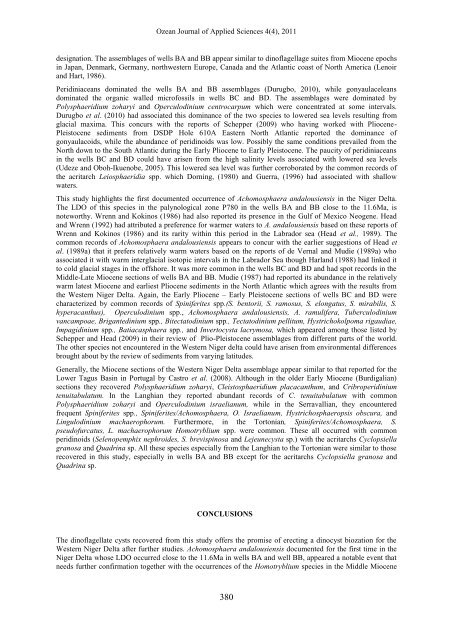download current issue - Ozean Publications
download current issue - Ozean Publications
download current issue - Ozean Publications
Create successful ePaper yourself
Turn your PDF publications into a flip-book with our unique Google optimized e-Paper software.
<strong>Ozean</strong> Journal of Applied Sciences 4(4), 2011<br />
designation. The assemblages of wells BA and BB appear similar to dinoflagellage suites from Miocene epochs<br />
in Japan, Denmark, Germany, northwestern Europe, Canada and the Atlantic coast of North America (Lenoir<br />
and Hart, 1986).<br />
Peridiniaceans dominated the wells BA and BB assemblages (Durugbo, 2010), while gonyaulaceleans<br />
dominated the organic walled microfossils in wells BC and BD. The assemblages were dominated by<br />
Polysphaeridium zoharyi and Operculodinium centrocarpum which were concentrated at some intervals.<br />
Durugbo et al. (2010) had associated this dominance of the two species to lowered sea levels resulting from<br />
glacial maxima. This concurs with the reports of Schepper (2009) who having worked with Pliocene-<br />
Pleistocene sediments from DSDP Hole 610A Eastern North Atlantic reported the dominance of<br />
gonyaulacoids, while the abundance of peridinoids was low. Possibly the same conditions prevailed from the<br />
North down to the South Atlantic during the Early Pliocene to Early Pleistocene. The paucity of peridiniaceans<br />
in the wells BC and BD could have arisen from the high salinity levels associated with lowered sea levels<br />
(Udeze and Oboh-Ikuenobe, 2005). This lowered sea level was further corroborated by the common records of<br />
the acritarch Leiosphaeridia spp. which Dorning, (1980) and Guerra, (1996) had associated with shallow<br />
waters.<br />
This study highlights the first documented occurrence of Achomosphaera andalousiensis in the Niger Delta.<br />
The LDO of this species in the palynological zone P780 in the wells BA and BB close to the 11.6Ma, is<br />
noteworthy. Wrenn and Kokinos (1986) had also reported its presence in the Gulf of Mexico Neogene. Head<br />
and Wrenn (1992) had attributed a preference for warmer waters to A. andalousiensis based on these reports of<br />
Wrenn and Kokinos (1986) and its rarity within this period in the Labrador sea (Head et al., 1989). The<br />
common records of Achomosphaera andalousiensis appears to concur with the earlier suggestions of Head et<br />
al. (1989a) that it prefers relatively warm waters based on the reports of de Vernal and Mudie (1989a) who<br />
associated it with warm interglacial isotopic intervals in the Labrador Sea though Harland (1988) had linked it<br />
to cold glacial stages in the offshore. It was more common in the wells BC and BD and had spot records in the<br />
Middle-Late Miocene sections of wells BA and BB. Mudie (1987) had reported its abundance in the relatively<br />
warm latest Miocene and earliest Pliocene sediments in the North Atlantic which agrees with the results from<br />
the Western Niger Delta. Again, the Early Pliocene – Early Pleistocene sections of wells BC and BD were<br />
characterized by common records of Spiniferites spp.(S. bentorii, S. ramosus, S. elongatus, S. mirabilis, S.<br />
hyperacanthus), Operculodinium spp., Achomosphaera andalousiensis, A. ramulifera, Tuberculodinium<br />
vancampoae, Brigantedinium spp., Bitectatodinium spp., Tectatodinium pellitum, Hystrichokolpoma rigaudiae,<br />
Impagidinium spp., Batiacasphaera spp., and Invertocysta lacrymosa, which appeared among those listed by<br />
Schepper and Head (2009) in their review of Plio-Pleistocene assemblages from different parts of the world.<br />
The other species not encountered in the Western Niger delta could have arisen from environmental differences<br />
brought about by the review of sediments from varying latitudes.<br />
Generally, the Miocene sections of the Western Niger Delta assemblage appear similar to that reported for the<br />
Lower Tagus Basin in Portugal by Castro et al. (2008). Although in the older Early Miocene (Burdigalian)<br />
sections they recovered Polysphaeridium zoharyi, Cleistosphaeridium placacanthum, and Cribroperidinium<br />
tenuitabulatum. In the Langhian they reported abundant records of C. tenuitabulatum with common<br />
Polysphaeridium zoharyi and Operculodinium israelianum, while in the Serravallian, they encountered<br />
frequent Spiniferites spp., Spiniferites/Achomosphaera, O. Israelianum, Hystrichosphaeropsis obscura, and<br />
Lingulodinium machaerophorum. Furthermore, in the Tortonian, Spiniferites/Achomosphaera, S.<br />
pseudofurcatus, L. machaerophorum Homotryblium spp. were common. These all occurred with common<br />
peridinoids (Selenopemphix nephroides, S. brevispinosa and Lejeunecysta sp.) with the acritarchs Cyclopsiella<br />
granosa and Quadrina sp. All these species especially from the Langhian to the Tortonian were similar to those<br />
recovered in this study, especially in wells BA and BB except for the acritarchs Cyclopsiella granosa and<br />
Quadrina sp.<br />
CONCLUSIONS<br />
The dinoflagellate cysts recovered from this study offers the promise of erecting a dinocyst biozation for the<br />
Western Niger Delta after further studies. Achomosphaera andalousiensis documented for the first time in the<br />
Niger Delta whose LDO occurred close to the 11.6Ma in wells BA and well BB, appeared a notable event that<br />
needs further confirmation together with the occurrences of the Homotryblium species in the Middle Miocene<br />
380

















